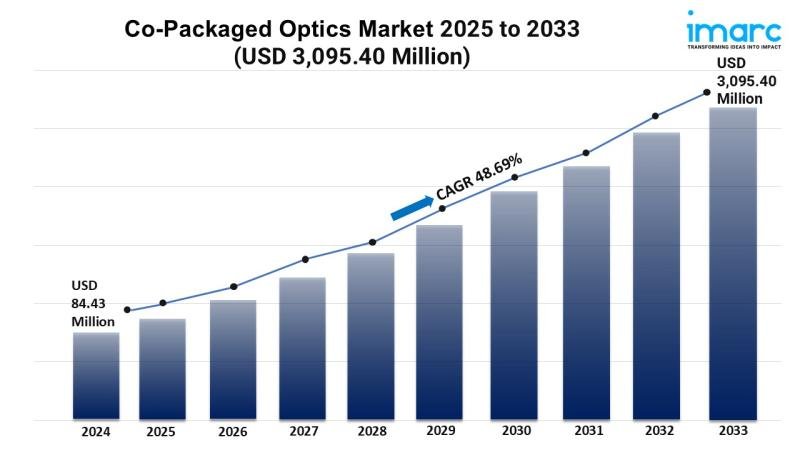Market Overview:
The co-packaged optics market is experiencing rapid growth, driven by exploding demand for high-speed data transmission and bandwidth density, increasing focus on energy efficiency in data centers, and advancements in optical and semiconductor packaging technologies. According to IMARC Group’s latest research publication, “Co-Packaged Optics Market Size, Share, Trends, and Forecast by Data Rates, Application, and Region, 2025-2033”, The global co-packaged optics market size was valued at USD 84.43 Million in 2024. Looking forward, IMARC Group estimates the market to reach USD 3,095.40 Million by 2033, exhibiting a CAGR of 48.69% during 2025-2033.
This detailed analysis primarily encompasses industry size, business trends, market share, key growth factors, and regional forecasts. The report offers a comprehensive overview and integrates research findings, market assessments, and data from different sources. It also includes pivotal market dynamics like drivers and challenges, while also highlighting growth opportunities, financial insights, technological improvements, emerging trends, and innovations. Besides this, the report provides regional market evaluation, along with a competitive landscape analysis.
Download a sample PDF of this report: https://www.imarcgroup.com/co-packaged-optics-market/requestsample
Our report includes:
● Market Dynamics
● Market Trends And Market Outlook
● Competitive Analysis
● Industry Segmentation
● Strategic Recommendations
Growth Factors in the Co-Packaged Optics Market
● Exploding Demand for High-Speed Data Transmission and Bandwidth Density:
The most potent growth factor driving the Co-Packaged Optics (CPO) market is the insatiable global demand for higher data transmission speeds and unprecedented bandwidth density within data centers and telecommunication networks. The proliferation of data-intensive applications such as artificial intelligence (AI), machine learning (ML), high-performance computing (HPC), and 5G network deployments is creating immense pressure on traditional optical interconnects. CPO technology directly addresses this challenge by integrating optical components directly with semiconductor devices, significantly reducing the electrical trace length, which in turn boosts data throughput and minimizes latency. This capability is critical for supporting the massive data traffic generated by cloud computing services and the complex computations required for AI workloads, positioning CPO as an essential solution for the next generation of high-capacity communication infrastructure.
● Increasing Focus on Energy Efficiency in Data Centers:
As data centers continue to expand their computational power and scale, their energy consumption has become a major concern, driving a strong demand for more energy-efficient networking solutions. This pressing need for power optimization is a significant growth factor for the Co-Packaged Optics market. Traditional pluggable optics require more power due to the longer electrical paths between the optical modules and the switch ASICs. CPO technology fundamentally reduces this power consumption by shortening the distance electrical signals need to travel, thereby minimizing energy loss. By integrating optical engines directly within the chip package, CPO can offer substantial power savings compared to conventional setups, helping hyperscale data centers lower their operational costs and meet increasingly stringent sustainability goals, making it an attractive and economically viable solution for future infrastructure.
● Advancements in Optical and Semiconductor Packaging Technologies:
Continuous innovation in optical and semiconductor packaging technologies is a crucial enabler and growth factor for the Co-Packaged Optics market. Breakthroughs in silicon photonics, 2.5D/3D integration, and advanced manufacturing processes are making it increasingly feasible and cost-effective to integrate complex optical components directly into chip packages. These technological advancements allow for higher integration density, improved signal integrity, and enhanced overall performance of CPO solutions. Companies are investing heavily in research and development to refine these packaging techniques, addressing challenges such as thermal management and fiber-to-chip alignment with greater precision. This ongoing technological progression is vital for overcoming the limitations of traditional interconnects and for unlocking the full potential of CPO, driving its adoption across various high-bandwidth applications.
Key Trends in the Co-Packaged Optics Market
● Proliferation of AI and Machine Learning Workloads:
A dominant trend in the Co-Packaged Optics market is its strong correlation with the explosive growth of Artificial Intelligence (AI) and Machine Learning (ML) workloads. The development and deployment of large language models (LLMs), generative AI, and other complex AI applications demand unprecedented levels of bandwidth and ultra-low latency within data centers. CPO is emerging as the backbone for these “AI factories” as it provides the necessary high-bandwidth density and power efficiency required to interconnect millions of GPUs and other processing units. The shift from traditional pluggable optics to CPO is becoming imperative for scaling AI clusters effectively, as CPO offers a superior solution for minimizing signal loss and power consumption over short distances within racks and between interconnected nodes, making it fundamental to the future of AI infrastructure.
● Drive Towards Standardization and Ecosystem Development:
While Co-Packaged Optics offers significant technical advantages, a key trend is the concerted industry effort towards standardization and the robust development of a collaborative ecosystem. Given the complexity of integrating optical and electrical components at the chip level, interoperability and common specifications are crucial for widespread adoption and mass production. Industry consortiums and leading technology companies are actively working together to define standards for CPO interfaces, packaging, and testing. This collaborative approach aims to reduce market fragmentation, foster innovation, and ensure that CPO solutions from different vendors can seamlessly interact. The development of a mature supply chain, involving semiconductor foundries, photonics manufacturers, packaging providers, and fiber optic specialists, is paramount to scaling CPO deployments and making the technology a mainstream solution.
● Evolution Towards Higher Data Rates and Advanced Modulations:
The Co-Packaged Optics market is trending towards supporting increasingly higher data rates and incorporating more advanced modulation techniques to meet future bandwidth demands. While 400G and 800G CPO solutions are becoming more prevalent, the industry is already setting its sights on 1.6T and beyond. This progression necessitates innovations in photonic integrated circuits (PICs) and the use of sophisticated modulation schemes like PAM-4 (Pulse Amplitude Modulation-4) to transmit more data per signal. Furthermore, there’s an exploration of more advanced optical engine designs and external laser sources to improve overall system efficiency and scalability. This continuous drive for higher data rates and spectral efficiency ensures that CPO technology remains at the forefront of optical interconnect innovation, capable of handling the ever-growing torrents of data in hyperscale and next-generation networks.
Buy Full Report: https://www.imarcgroup.com/checkout?id=15666&method=1670
Leading Companies Operating in the Global Co-Packaged Optics Industry:
● Broadcom Inc.
● Lumentum Operations LLC
● Ranovus
Co-Packaged Optics Market Report Segmentation:
By Data Rates:
● Less than 1.6T and 1.6T
● 3.2T
● 6.4T
On the basis of the data rates, the market has been classified into less than 1.6T and 1.6T, 3.2T, and 6.4T.
By Application:
● Data Centers and High-Performance Computing (HPC)
● Telecommunications and Networking
● Others
Based on the application, the market has been divided into data centers and high-performance computing (HPC), telecommunications and networking, and others.
Regional Insights:
● North America (United States, Canada)
● Asia Pacific (China, Japan, India, South Korea, Australia, Indonesia, Others)
● Europe (Germany, France, United Kingdom, Italy, Spain, Russia, Others)
● Latin America (Brazil, Mexico, Others)
● Middle East and Africa
North America enjoys the leading position in the co-packaged optics market on account of favorable government policies and initiatives supporting digital infrastructure development.
Ask Analyst for Sample Report: https://www.imarcgroup.com/request?type=report&id=15666&flag=C
Research Methodology:
The report employs a comprehensive research methodology, combining primary and secondary data sources to validate findings. It includes market assessments, surveys, expert opinions, and data triangulation techniques to ensure accuracy and reliability.
Note: If you require specific details, data, or insights that are not currently included in the scope of this report, we are happy to accommodate your request. As part of our customization service, we will gather and provide the additional information you need, tailored to your specific requirements. Please let us know your exact needs, and we will ensure the report is updated accordingly to meet your expectations.
Contact Us:
IMARC Group
134 N 4th St. Brooklyn, NY 11249, USA
Email: sales@imarcgroup.com
Tel No:(D) +91 120 433 0800
United States: +1-631-791-1145
About Us:
IMARC Group is a global management consulting firm that helps the world’s most ambitious changemakers to create a lasting impact. The company provide a comprehensive suite of market entry and expansion services. IMARC offerings include thorough market assessment, feasibility studies, company incorporation assistance, factory setup support, regulatory approvals and licensing navigation, branding, marketing and sales strategies, competitive landscape and benchmarking analyses, pricing and cost research, and procurement research.
This release was published on openPR.


















